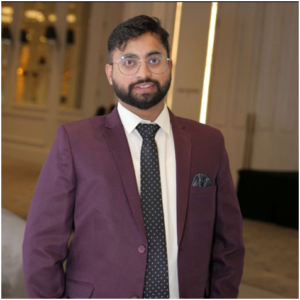
DEEP LEARNING
UNRAVELING THE SECRETS OF NEURAL NETWORKS
AUTHOR(S) -
MUHAMMAD ALI KHAN, SEJUTI SARKER TINNY, PIYUSH RANJAN, VARUN SHAH
DOI – 10.61909/AMKEDTB062430
Genre/Subject – Computer Science, Deep Learning, Machine Learning, Neural Network
Book code – AMKEDTB082430
pgs: 224
ISBN(E) – 978-93-6556-973-5
ISBN(P) – 978-93-6556-117-3
Published – 06/08/2024
AUTHOR(S)

MUHAMMAD ALI KHAN
Mr. Muhammad Ali Khan is a dedicated and accomplished professional in the field of Computer Science, currently serving as a Lecturer at Minhaj University Lahore in the School of Information Technology. He holds an M.Phil. in Computer Science (2021-2023) and a BS in Software Engineering (2015-2019) from Minhaj University Lahore. His teaching career includes significant roles such as Registrar of the BS Program and Head of the Computer Science Department at Concordia College Johar Town Campus Lahore.
His academic journey is marked by a commitment to excellence and continuous learning. His research expertise lies in Deep Learning and Artificial Intelligence, with several notable publications contributing to these advanced fields. His experience encompasses various facets of computer science education, including curriculum development, student mentorship, and industry collaboration.
https://orcid.org/0009-0008-2084-3052

SEJUTI SARKER TINNY
Ms. Sejuti Sarker Tinny is a high school graduate student with an insatiable curiosity for the world of Data Science. Despite her young age, she has already delved deep into the realms of statistics, programming and machine learning, fueled by a passion for unravelling the mysteries hidden within vast datasets. Tinny’s journey into data science began with a simple fascination for numbers, which quickly evolved into a fervent desire to understand the stories they tell. With a keen eye for detail and a knack for problem solving, she has embarked on numerous data analysis projects, exploring diverse topics ranging from environmental trends to socioeconomic patterns. Tinny’s writing reflects her dedication to demystifying complex concepts and making them accessible to readers of all backgrounds. Through her contributions to this book, she hopes to inspire fellow students to embark on their adventures in the captivating world of data science.

PIYUSH RANJAN
I am Piyush Ranjan, an IEEE Vice Chair (AES Chapter) with a passion for writing and reviewing scholarly articles across various forums. With 18 years of industry expertise, I currently hold the position of Assistant Vice President at a reputable firm in the USA.
As an Assistant Vice President, I leverage extensive design experience and a successful track record in the technology industry, particularly in AI and digital transformation initiatives.
I excel in fostering teamwork, aligning project goals with business objectives, and managing cross-functional collaborations with architects and product owners. My problem-solving approach emphasizes setting clear priorities, removing impediments, and nurturing a collaborative work environment. Additionally, my experience in AI and digital transformation enables me to drive innovative solutions and enhance operational efficiencies within the organization.

VARUN SHAH
Mr. Varun Shah, based in San Francisco, California, is a seasoned Software Development Manager renowned for his transformative leadership across esteemed organizations. With a proven track record at Amazon Service LLC, Service Now, Sony PlayStation, and Medimpact Healthcare Systems, Varun has spearheaded groundbreaking initiatives, including the launch of life-safety applications for Amazon’s global operations, premium services for Service Now Vault, and scalable payment methods for Sony PlayStation. His strategic restructuring has consistently optimized development processes, resulting in substantial cost savings and compliance achievements. Varun’s dedication to mentorship and innovation has not only elevated his teams but has also propelled him as a respected figure in the technology and healthcare sectors. With a Bachelor of Engineering degree in Information Technology and expertise spanning Java, AWS, Agile methodologies, and more, Varun continues to drive impact and foster talent within his spheres of influence.
ABOUT BOOK / ABSTRACT
“Deep Learning: Unraveling the Secrets of Neural Networks” is a comprehensive guide designed for both beginners and advanced learners eager to delve into the world of deep learning. This meticulously structured book takes readers on a journey through the fundamentals, intricacies, and advanced concepts of neural networks, making it an indispensable resource for anyone looking to understand or enhance their knowledge in this field.
Starting with Chapter 1, the book introduces deep learning by defining its core concepts and tracing its historical evolution. It distinguishes between machine learning and deep learning, highlighting their unique attributes. Key terminologies and concepts are elucidated, providing a solid foundation for readers. The chapter also explores the diverse applications of deep learning across industries, the challenges faced, the tools and frameworks available, and the future directions the field might take.
In Chapter 2, readers are introduced to the basics of neural networks. This chapter covers the structure and function of neural networks, including activation functions, feedforward and backpropagation mechanisms, and loss functions. It also discusses various types of neural networks and the metrics used for training and evaluation, culminating in a practical example of building a simple neural network.
Chapter 3 delves into Convolutional Neural Networks (CNNs), which are pivotal in image processing tasks. The chapter explains the components of CNNs, such as convolutional layers, pooling layers, and fully connected layers. It discusses different CNN architectures, transfer learning techniques, and advanced methods, offering readers a deep dive into CNNs’ capabilities.
Recurrent Neural Networks (RNNs) are the focus of Chapter 4. This chapter covers the basics of RNNs, sequence modeling, and various types of RNNs, including LSTM and GRU. It also discusses the applications of RNNs, the challenges in training them, advanced architectures, and practical implementations, such as time series forecasting.
Chapter 5 explores Generative Adversarial Networks (GANs), detailing their architecture, training methods, and applications. The chapter also covers variants of GANs and the challenges associated with their training, supported by a case study on image generation and insights into the future of GANs.
Chapter 6 introduces Deep Reinforcement Learning, covering key concepts, methodologies, and case studies, such as game playing and robotics. It differentiates between model-free and model-based methods and discusses advanced techniques and challenges in this domain.
Natural Language Processing (NLP) with deep learning is covered in Chapter 7. This chapter addresses key NLP tasks, embedding techniques, sequence-to-sequence models, attention mechanisms, and advanced models like Transformers and BERT. It highlights applications in text generation and translation, offering a glimpse into future trends in NLP.
In Chapter 8, the book focuses on Deep Learning in Computer Vision, discussing image classification, object detection, semantic segmentation, and image generation. It also explores real-world applications like autonomous vehicles and medical imaging, supported by tools and frameworks for computer vision.
Chapter 9 delves into advanced topics such as meta-learning, neural architecture search, explainable AI, few-shot learning, federated learning, self-supervised learning, and multi-modal learning, addressing the challenges and future directions in these areas.
Chapter 10 provides practical guidance on implementing deep learning models using frameworks like TensorFlow, PyTorch, and Keras. It covers model deployment, performance optimization, and debugging, supported by end-to-end implementation case studies.
The ethical implications of deep learning are discussed in Chapter 11, highlighting issues like bias, fairness, privacy, regulatory aspects, and the impact on jobs and society. It promotes responsible AI practices through case studies and future directions for ethical AI.
Finally, Chapter 12 looks to the future of deep learning, discussing emerging trends, potential breakthroughs, integration with other fields, and the role of deep learning in addressing global challenges. It emphasizes the importance of community and collaborative research, educational pathways, and concludes with reflections on the road ahead for deep learning.
“Deep Learning: Unraveling the Secrets of Neural Networks” is not just a book; it’s a roadmap for anyone looking to navigate the rapidly evolving landscape of deep learning, offering a blend of theoretical insights and practical knowledge.






